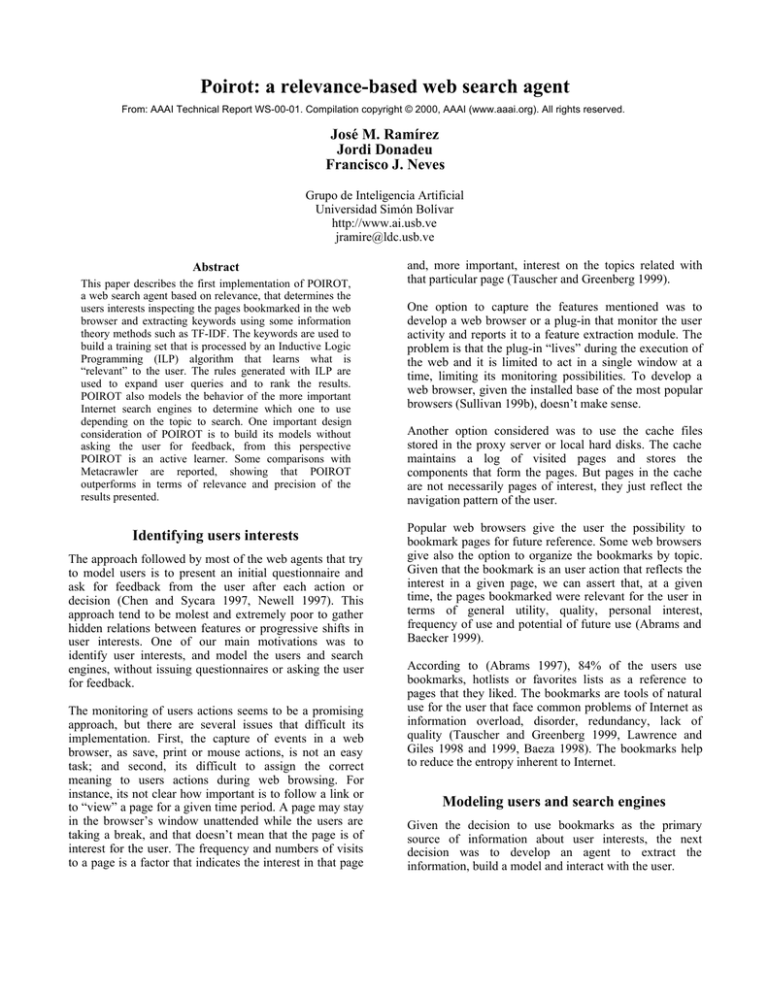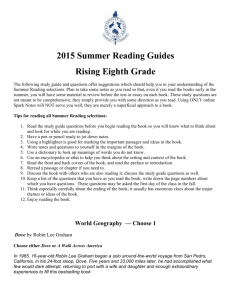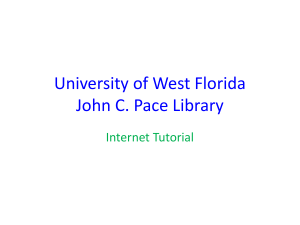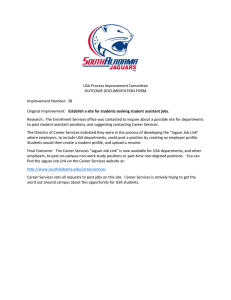
Poirot: a relevance-based web search agent
From: AAAI Technical Report WS-00-01. Compilation copyright © 2000, AAAI (www.aaai.org). All rights reserved.
José M. Ramírez
Jordi Donadeu
Francisco J. Neves
Grupo de Inteligencia Artificial
Universidad Simón Bolívar
http://www.ai.usb.ve
jramire@ldc.usb.ve
Abstract
This paper describes the first implementation of POIROT,
a web search agent based on relevance, that determines the
users interests inspecting the pages bookmarked in the web
browser and extracting keywords using some information
theory methods such as TF-IDF. The keywords are used to
build a training set that is processed by an Inductive Logic
Programming (ILP) algorithm that learns what is
“relevant” to the user. The rules generated with ILP are
used to expand user queries and to rank the results.
POIROT also models the behavior of the more important
Internet search engines to determine which one to use
depending on the topic to search. One important design
consideration of POIROT is to build its models without
asking the user for feedback, from this perspective
POIROT is an active learner. Some comparisons with
Metacrawler are reported, showing that POIROT
outperforms in terms of relevance and precision of the
results presented.
Identifying users interests
The approach followed by most of the web agents that try
to model users is to present an initial questionnaire and
ask for feedback from the user after each action or
decision (Chen and Sycara 1997, Newell 1997). This
approach tend to be molest and extremely poor to gather
hidden relations between features or progressive shifts in
user interests. One of our main motivations was to
identify user interests, and model the users and search
engines, without issuing questionnaires or asking the user
for feedback.
The monitoring of users actions seems to be a promising
approach, but there are several issues that difficult its
implementation. First, the capture of events in a web
browser, as save, print or mouse actions, is not an easy
task; and second, its difficult to assign the correct
meaning to users actions during web browsing. For
instance, its not clear how important is to follow a link or
to “view” a page for a given time period. A page may stay
in the browser’s window unattended while the users are
taking a break, and that doesn’t mean that the page is of
interest for the user. The frequency and numbers of visits
to a page is a factor that indicates the interest in that page
and, more important, interest on the topics related with
that particular page (Tauscher and Greenberg 1999).
One option to capture the features mentioned was to
develop a web browser or a plug-in that monitor the user
activity and reports it to a feature extraction module. The
problem is that the plug-in “lives” during the execution of
the web and it is limited to act in a single window at a
time, limiting its monitoring possibilities. To develop a
web browser, given the installed base of the most popular
browsers (Sullivan 199b), doesn’t make sense.
Another option considered was to use the cache files
stored in the proxy server or local hard disks. The cache
maintains a log of visited pages and stores the
components that form the pages. But pages in the cache
are not necessarily pages of interest, they just reflect the
navigation pattern of the user.
Popular web browsers give the user the possibility to
bookmark pages for future reference. Some web browsers
give also the option to organize the bookmarks by topic.
Given that the bookmark is an user action that reflects the
interest in a given page, we can assert that, at a given
time, the pages bookmarked were relevant for the user in
terms of general utility, quality, personal interest,
frequency of use and potential of future use (Abrams and
Baecker 1999).
According to (Abrams 1997), 84% of the users use
bookmarks, hotlists or favorites lists as a reference to
pages that they liked. The bookmarks are tools of natural
use for the user that face common problems of Internet as
information overload, disorder, redundancy, lack of
quality (Tauscher and Greenberg 1999, Lawrence and
Giles 1998 and 1999, Baeza 1998). The bookmarks help
to reduce the entropy inherent to Internet.
Modeling users and search engines
Given the decision to use bookmarks as the primary
source of information about user interests, the next
decision was to develop an agent to extract the
information, build a model and interact with the user.
The first problem in the design of the agent was to
identify the features that determine that a given page is of
interest for the user. The interest of a user, as we
mentioned above, can be determined by several factors,
but all of them are associated with the topics covered by
the page, so we need to determine what are the topics
covered by a given page in order to determine if that page
is relevant for the user and its degree of relevance.
where |D| is the total number of evaluated documents.
The weight of a given word in a document is computed
using equation (2). The higher the value of d(i), higher is
the significance of the word within the document.. Note
that the significance of a word within a document
decreases if DF increases, given that if a word is very
frequent in a set of documents, that word won’t help us to
“separate” the documents in the feature space.
d(i) = TF (p i , d) IDF(wi )
The topics of a document are not necessarily written
explicitly, for instance, a page of a college may mention
words as “university”, “faculty”, “schedules” but the term
“education” may not appear. Moreover, if that term
appears, how to determine that is related to the topics of
the page?. Clearly, the topics covered by a web page are
determined from the words that are written in the page,
the problem is to rank the words in the page according to
the relation with the topic of the page.
One alternative is to infer the topics covered by a
document given the frequency of appearance of certain
words in the document and a relation established between
those words and the topics. In other words, the words that
are more related with the topic of a document should be
more frequent than others, and pages that cover same
topics should share the same set of frequently used words.
(Joachims 1998) suggests to use a feature vector
consisting in a word counting vector. Each word has an
associated importance, computed based on the frequency
of appearance, that serve as input to a Support Vector
Machine (SVM) (Haykin 1999, Burges 1998, Osuna et al.
1997, Nilsson 1999, Pontil and Verri 1997) that
determines the proper classification of the document. The
problem with this approach, in addition to the
computational cost of SVM, is the lack of important
features as incremental learning that would give the agent
the ability to adapt to user changes.
(2)
As an adaptation of TF-IDF to our particular problem, we
assign additional weights to the words according to their
position in the HTML document, higher for words
appearing in the “keyword tag”, titles, headers, etc. and
lower for normal text.
Once the words in each document are ranked, we need to
infer rules that, starting from these initial documents (the
pages bookmarked by the user), help us to determine the
relevance of new pages. This problem can be addressed as
inductive concept learning, where the concept to learn
(right-hand side of the rules) is “relevance” and the
conditions (left-hand side) are logic expressions based on
topics found in documents. The pages bookmarked by the
users are used as the training set, they are all positive
instances of the concept.
Inductive Logic Programming (Bergadano and Gunetti
1995) was selected, instead of other inductive methods as
Neural Networks, to infer rules due to its ability to derive
rules of variable number of conditions, resulting in
specific rules (many conditions) that give us precision and
general rules (few conditions) that help us to maintain
coverage in the search. We limit the number of topics to
appear in the left-hand side of rules to 10, to avoid the
over-fitting of the agent. The topics with higher ranking
are used to build rules of the form:
If (topic1, topic2, … topicn) then Relevant with RF
(Salton and McGill 1983) present a method to compute a
weighted word counting, using weights determined by an
algorithm called TF-IDF (Term Frequency – Inverse
Document Frequency) that became a standard in
information retrieval.
The general idea is to represent each document as a vector
in a feature space, where documents with similar topics
should be “closer” in the space that unrelated ones, given
a distance metric. Each dimension of the feature space
represents a word and its weight. The weights are
computed based on the frequency of the word, TF(p,d),
and frequency of documents, DF(p). From DF the
inverse, IDF(p), is computed as shown in (1).
IDF ( w) = log
D
DF ( w)
(1)
Where RF is the relevant factor computed from the
ranking of the topics included in the rule.
Once the initial rules are generated, ILP techniques are
applied to that rules to generate aggregated rules that are
also incorporated to the rule base. The result is a rule base
with rules extracted directly from documents and more
general rules that apply to the entire set. This maintains
the required balance between precision and coverage that
is shown in the results.
The last issue to address is the modeling of the
repositories, search engines in our case; allowing the
agent to select the search engine with higher probability
to give good results for a particular topic. We use a
strategy similar to TF-IDF, maintaining a vector for each
3
topic, representing the frequency of appearing in each
search engine.
Altavista, Yahoo!, Infoseek, Lycos and WebCrawler
where used as the search engines of our agent, given that
there is consensus about their high coverage and quality
(Sonnenreich and Macinta 1998, Sullivan 1999a and
1999b, Hock 1999,
Search Engines: Education,
information and great links 1999). We need to use several
search engines, given that the overlap of pages indexed by
the search engines is low (Sullivan 1999). The problem
with this decision is that the agent must understand the
protocol used by each search engine to receive queries
and integrate the results in an unified interface.
• Checkboxes to select the browsers to use. This
selection supersedes the selection made by POIROT
based on the topics of the search. (3)
• Control of how many hits to return. (4)
• Search buttons. (5)
• Keyword edit field. (6)
• Results window. (9)
• Description window. When an URL is selected in the
result window, its description is displayed here. (11)
Architecture of the agent
Figure 1 shows the architecture of POIROT.
The Topic extraction module reads the bookmarks file
and visit each URL to extract the topics of interest for the
user. This module reads the HTML of all the bookmarked
pages, discard HTML code and stopwords (Cambridge
Scientific Abstracts Stopword List, Library of Congress
1999), and compute the count of words to be stored in the
table “URL/Topic”
The search engines module receives the expanded query
and the selected search engines, according to the topics in
the query, and sends the requests to each search engine
using different threads. Also receive the results from the
search engines.
Figure 2 - User Interface of POIROT
Given a set of documents, the TF/IDF module computes
and assigns the weights to each word to reflect the relative
importance within the document and the set.
The ILP module generates the rules according to the
weights computed and also assigns the relevance factor to
the links returned. This relevance factor is used to expand
the queries, rank the results and present them in that order
to the user.
Results
We performed experiments with several user profiles of at
least 20 bookmarks of specific subjects. The search
engine used for comparisons was MetaCrawler.
In the first experiment we explore the capacity of the
agent to find relations between relevant subjects. The
second experiment was designed to verify the
generalization ability of the agent, when the user does not
use keywords that match exactly with the relevant
subjects. Finally the third experiment presented test the
capacity of the agent to adapt to changing interests.
Figure 1 - Agent architecture
The user interface is shown in figure 2. Some important
components are:
In each experiment we report the hits returned, that is a
good measure of coverage; the position of the first
relevant link, that measure how good is the agent to rank
the results and the percentage of relevant links in the
first 20 links returned, that intend to give an idea of the
precision of the agent.
User interested in “submarine tourism”
When a user with 23 bookmarks related with scuba diving
and tourism, performs a query with the keyword: “diving”
the results obtained by POIROT and MetaCrawler are
presented in table 1.
The coverage, relevance and precision of POIROT
outperform MetaCrawler. The difference in the
percentage of relevant links in the first 20 links is 45%,
this maximize the probability to find a good link in the
first page returned by the agent. In the first 20 links
POIROT returned just 1 link that was not related with the
user interests.
POIROT MetaCrawler
Hits returned
413
70
Position of the first relevant
1
3
link
Percentage of relevant links
95%
50%
in the first 20 links
Table 1 User interested in "submarine tourism"
User interested in “Salvador Dalí”
In this case, using a profile with 21 bookmarks about
Dalí, the user submits the query: “Surrealism”, which is
related with the subject of interest, but is not included in
the subject description. The results are shown in table 2.
Again the first and more that 50% of the first 20 links
returned by POIROT were relevant.
POIROT MetaCrawler
Hits returned
407
72
Position of the first relevant
1
10
link
Percentage of relevant links
55%
10%
in the first 20 links
Table 2 User interested in "Salvador Dalí”
User interested in “Jaguars”
This experiment was divided in 3 parts, using the
ambiguity associated with the subject “jaguar”1. In the
first part the user was interested in Jaguars, the cats; in the
second part the user was changing interests from cats to
cars and in the third part the user is totally interested in
cars.
1
The idea of this experiment was taken from (Baeza
1998).
“Jaguar” is a word related with several subjects, such as
cars, video game consoles, a football team and a pop
group. The agent was able to resolve the ambiguity using
the context created by the rules inferred.
With a profile consisting in 43 bookmarks related with
jaguar cats, the results of issuing the query: “jaguar” are
presented in table 3. POIROT expanded the query to
“jaguar nature”. The results are impressive in terms of
relevance and precision.
POIROT MetaCrawler
Hits returned
421
67
Position of the first relevant
1
43
link
Percentage of relevant links
95%
0%
in the first 20 links
Table 3 - User interested in "Jaguar, the cat”
Using a profile of 43 bookmarks related to cats and 20
related to cars, simulating a progressive changing of
interests from cats to cars and issuing the same query:
“jaguar”, the results are shown in table 4.
This time POIROT expanded the query to “jaguar haynes
workshop usually manual sports british pubns crowood
motorbooks bentley hours complete robert international
edition”. This expansion, apparently meaningless,
captures the keywords present in web pages relevant to
jaguar cats and cars.
POIROT MetaCrawler
Hits returned
315
67
Position of the first relevant
3
43
link (cats)
Position of the first relevant
1
2
link (cars)
Percentage of relevant links
30%
0%
in the first 20 links (cats)
Percentage of relevant links
55%
85%
in the first 20 links (cars)
Table 4 - User interested in "Jaguars, cats and cars”
The results are clear, showing how POIROT distributed
the links presented between the two subjects, according to
the interest shift of the user. MetaCrawler was victim
once again of its lack of knowledge about user interests.
Note that the number of pages related to jaguar cars is
considerably higher than the related to cats; that explain
that the first link reported by POIROT was related to cars
and the third to cats.
In the last step of this experiment, the user changed totally
and now he is interested in jaguar cars. The results are
presented in table 5
5
POIROT MetaCrawler
Hits returned
404
67
Position of the first relevant
1
2
link
Percentage of relevant links
95%
85%
in the first 20 links
Table 5 - User interested in "Jaguar, the car”
These results are consistent with the previous one; but
what is curious is that, even in this case, MetaCrawler
didn’t report a relevant link in the first position, and the
first link reported correspond to a Football team, the
“Jacksonville Jaguars”. This experiment illustrates the
adaptive capacity of POIROT.
Discussion
According to the results, its clear that POIROT is able to:
• Learn relations between the subjects of interest to the
user.
• Identify subjects related to the user interests.
• Resolve context issues regarding queries using the user
profile.
• Adapt to interest shifts
The bookmarks proved to serve as a good and relative
easy to access source of information regarding user
interests, compared with the use of other sources as the
local or proxy caches or the monitoring of user actions.
The extraction of subjects related to web pages,
performed with a combination of the TF-IDF computation
and a weighting based on the hierarchy of the html tags,
was successful and allowed to characterize users interests
and learn what was relevant to the user.
We didn’t pay attention to the time required by the agent
to perform the search. The time is generally higher than
the needed by MetaCrawler, but given the percentage of
relevant links in the first 20 links is very high, there is no
need to navigate through several results pages or to
manually improve the search to find the desired
information.
The use of dictionaries and Thesaurus would probably
improve the performance of the agent, allowing
identifying synonyms, derivations, useful in the query
expansion rule generation and multi-language support.
Another important aspect is the exploration of alternative
sources of information about user interests. In particular
we are interest in the monitoring of users actions such as
follow a link, save or print a web page, etc. We will
explore these issues in a forthcoming article.
References
Abrams, David 1997, Human Factors of Personal Web
Information Spaces, Thesis University of Toronto.
Abrams, David; Baecker, Ron 1999, How People Use
WWW
Bookmarks,
http://www.acm.org/turing/sigs/sigchi/chi97/proceedings/
short-talk/da.htm
Baeza, Ricardo 1998. Searching the World Wide Web:
Challenges and Partial Solutions. In Progress in Artificial
Intelligence – Proceedings of Iberamia 98.
Bergadano, Francesco; Gunetti, Daniele 1995, Inductive
Logic Programming – From Machine Learning to
Software Engineering, The MIT Press.
Burges, Christopher 1998, A Tutorial on Support Vector
Machines for Pattern Recognition Bell Laboratories,
Lucent Technologies.
Cambridge Scientific Abstracts
www.csa.com/stoplist.html
Stopword
List,
Chen, L.; Sycara, K. 1997, WebMate, A Personal Agent
for Browsing and Searching, The Robotics Institute,
Carnegie Mellon University.
Haykin, Simon 1999, Neural Networks
Comprehensive Foundation, Prentice Hall.
–
A
Hock, Randolph 1999, The Extreme Searcher’s Guide to
Web Search Engines, CyberAge Books.
Joachims, Thorsten 1998, Text Categorization with
Support Vector Machines: Learning with many Relevant
Features. Fachbereich Informatik, Universität Dortmund.
Lawrence, S.; Giles, C.L. 1998, Searching the world wide
web. Science, 280(5360):98.
Lawrence S.; Giles, C.L. 1999. Accessibility
Information On The Web. Nature, 400; 8.
Library
of
Congress
1999,
thomas.loc.gov/home/stopwords.html
of
stopwords,
Newell, Sima 1997, Improved Internet Information
Retrieval Through the Use of User Models, Filtering
Agents and a Knowledge-Based System, Thesis, McGill
University.
Nilsson, Nils J. 1999, Introduction to Machine Learning
(Draft version), Department of Computer Science,
Stanford University.
Osuna, Edgar; Freund, Robert; Girosi, Federico 1997,
Support Vector Machines: Training and Applications,
Technical Report MIT Center for Biological and
Computational Learning.
Pontil, Massimiliano; Verri, Alessandro 1997, Properties
of Support Vector Machines, MIT Artificial Intelligence
Laboratory Memo nº1612 and Center for Biological and
Computational Learning Department of Brain and
Cognitive Sciences Paper nº 152.
Salton G., McGill, M. G. 1983, Introduction to Modern
Information Retrieval. McGraw-Hill, New York.
Search Engines: Education, Information and Great Links.
people.delphi.com/ulialex/search_engines
Sonnenreich, Wes; Macinta, Tim 1998, Guide to Search
Engines, John Wiley & Sons.
Sullivan, Danny ed. 1999a. How Search Engines Work
and
Search
Engine
Features
Chart,
www.searchenginewatch.com/
Sullivan, Danny ed. 1999b, The Search Engine Report
33,
http://www.searchenginewatch.com/sereport/index.html
Tauscher, Linda; Greenberg, Saul 1999, Revisitation
Patterns
in
World
Wide
Web
Navigation,
www.acm.org/sigchi/chi97/proceedings/paper/sg.htm







